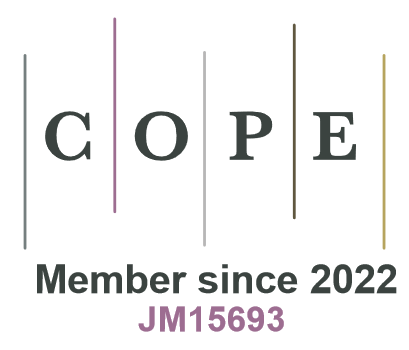Does human sexual dimorphism influence fracture frequency, types and distribution?
DOI:
https://doi.org/10.2478/v10044-010-0002-3Keywords:
interpretation of injuries, gender roles, medieval DenmarkAbstract
This study explores the hypothesis that the pattern of gender inequality in a community influences the frequency, patterns and distribution of fractures. As it is not possible to read gender relations from skeletons, it is - following several research results - assumed that the level of gender inequality is reflected in sexual dimorphism. Thus the study design consists in correlating a measure of sexual dimorphism with measures of frequencies, patterns and distribution of skeletal trauma between the two sexes. Nearly two hundreds individuals from two medieval Danish cemeteries have been examined (43 females/48 males from Jutland and 46 females/49 males from Funen). Sexual dimorphism was assessed by means of measurements on the pelvis and, in accordance with conventional wisdom, the level of sexual dimorphism was found to be lower in the Funen than in the Jutland sample. The fracture frequencies, patterns and distribution were estimated for the two skeletal samples. No significant difference between the fracture frequencies or types on the two sites was found, but the distribution of fractures between the sexes in Ribe was found to be significantly different. The study indicates a level of relationship between human sexual dimorphism, gender roles, and the distribution of fractures between the sexes. Studies of larger samples will help clarify this.
Downloads
References
Bass W.M., 2005, Human Osteology. A Laboratory and Field Manual, 5. Ed., Missouri Archaeological Society, Columbia
View in Google Scholar
Christensen A.S., 1988, Middelalderbyen Odense, Centrum, Viby J.
View in Google Scholar
Christensen J.T., 1999, Døden Skiller - Om Kirkegårdsskel og Skik under Skt. Knuds Plads, [in:] Fynske Minder 1999, Odense Universitetsforlag, Odense, pp. 83-92
View in Google Scholar
Eriksen T.H., 1998, Små Steder - Store Spørgsmål, Innføring I Sosialantropologi, Universitetsforlaget, Oslo
View in Google Scholar
González-Reimers E., J. Velasco-Vázquez, M. Arnay-de-la-Rosa, F. Santolaria-Fernndez, 2000, Sex Determination by Discriminant Function Analysis of the Right Tibia in the Prehispanic Population of the Canary Islands, Forensic Sci. Int., 108, 165-72
View in Google Scholar
Grauer A.L., P. Stuart-Macadam, 1998, Sex and Gender in Paleopathological Perspective, Cambridge University Press, Cambridge
View in Google Scholar
Hammond P.B., 1964, Cultural and Social Anthropology, Selected Reading, MacMillian, New York
View in Google Scholar
İşcan M.Y., P. Miller-Shaivitz, 1984, Discriminant Function Sexing of the Tibia, J. Forensic Sci., 4, 1087-93
View in Google Scholar
İşcan M.Y., M. Yoshino, S. Kato, 1994, Sex Determination from the Tibia: Standards for Contemporary Japan, J. Forensic Sci., 3, 785-92
View in Google Scholar
Judd M.A., 2002a, Ancient Injury Recidivism: An Example from the Kerma Period of Ancient Nubia, Int. J. Osteoarchaeol., 12, 89-106
View in Google Scholar
Judd M.A., 2002b, One Accident too Many?, BMSAES, 3, 42-54
View in Google Scholar
Judd M.A., 2004, Trauma in the City of Kerma: Ancient versus Modern Injury Patterns, Int. J. Osteoarchaeol., 14, 34-51
View in Google Scholar
Judd M.A., 2006, Continuity of Interpersonal Violence Between Nubian Communities, Am. J. Phys. Anthropol., 131, 324-33
View in Google Scholar
Judd M.A., 2008, The Parry Problem, J. Archaeol. Sci., 35, 1658-66.
View in Google Scholar
Kanazawa S., D.L. Novak, 2005, Human Sexual Dimorphism in Size May Be Triggered by Environmental Cues, J. Biosoc. Sci., 37, 657-65
View in Google Scholar
Mays S., 1998, The Archaeology of Human Bones, Routledge, London and New York
View in Google Scholar
McGee R.J., R.L. Warms, 2000, Anthropological Theory: An Introductory History, Mayfield, Mountain View
View in Google Scholar
McWhirr A., L. Viner, C. Wells, 1982, Romano-British Cemeteries at Cirencester, Cirencester Excavation Committee, Cirencester
View in Google Scholar
Murail P., J. Bruzek, F. Houët, E. Cunha, 2005, DSP: A Tool for Probabilistic Sex Diagnosis Using Worldwide Variation in Hip-Bone Measurements, Bull. Mém. Soc. Anthropol. Paris, 17, 167-76
View in Google Scholar
Nielsen I., 1985, Middelalderbyen Ribe, Centrum, Viby J.
View in Google Scholar
Nielsen O.V., 1970, The Nubian Skeleton through 4000 Years (Metrical and Non-metrical Anatomical Variations), Andelsbogtrykkeriet, Odense
View in Google Scholar
Rich J., D.E. Dean, R.H. Powers, 2005, Forensic Medicine of the Lower Extremity, human Identification and Trauma Analysis of the Thigh, Leg, and Foot, Humana Press, Totowa
View in Google Scholar
Rösing F.W., 1990, Qubbet el Hawa und Elephantine, zur Bevölkerungsgeschichte von Ägypten, Gustav Fischer, Stuttgart
View in Google Scholar
Šlaus M., Ž. Tomičic, 2005, Discriminant Function Sexing of Fragmentary and Complete Tibiae from medieval Croatian Sites, Forensic Sci. Int., 147, 147-52
View in Google Scholar
Smith G.E., F.W. Jones, 1910, Archóological Survey of Nubia, Report 1907-1908. Volume II incl. Plats, National Printing Department, Cairo
View in Google Scholar
Smith M.O., 1996, ‘Parry’ Fractures and Female-directed Interpersonal Violence: Implications from the Late Archaic Period of West Tennessee, Int. J. Osteoarchaeol., 6, 84-91
View in Google Scholar
Steyn M., M.Y. İşcan, 1997, Sex Determination from the Femur and Tibia in South African Whites, Forensic Sci. Int., 90, 111-19
View in Google Scholar
Downloads
Published
How to Cite
Issue
Section
License

This work is licensed under a Creative Commons Attribution-NonCommercial-NoDerivatives 4.0 International License.








